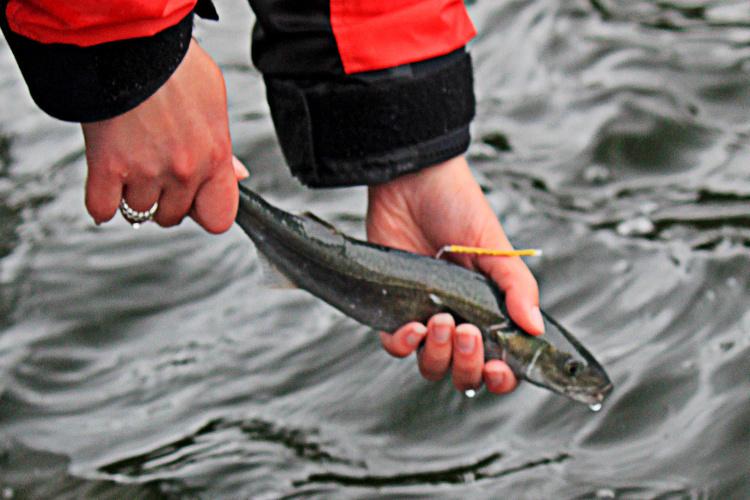NOAA’s Alaska Fisheries Science Center assesses sablefish populations and their role in Alaska ecosystems to provide information critical for the conservation and management of this prized species.
Sablefish Surveys

NOAA Sablefish researcher.
We collect information on the number, age, length, weight, and biology (such as maturity and genetics) of sablefish during longline surveys in the Bering Sea, Aleutian Islands, and Gulf of Alaska. These data are combined with information collected from other surveys and by fishery observers to determine the population health of Alaska sablefish.
Our longline survey has one of the longest and most extensive tagging programs in the nation. We use a wide variety of techniques, from manually recovered spaghetti tags to satellite transmitters, to track sablefish. The data we collect, combined with other tagging data from national and international survey platforms, provide a unique opportunity for understanding sablefish distributions and movement over time.
During our longline surveys, we also collect environmental data, record seabird interactions with longline gear, and observe whale depredation on sablefish caught on longline gear. As a result, we are able to gain insight into the role of sablefish and the sablefish fishery in the ecosystem.

Early Life Studies
Survival of young sablefish to recruitment (when they reach a size available to the fishery and the survey, around 2 years of age) varies dramatically from year to year. Understanding what causes these fluctuations is a research priority for the Alaska Fisheries Science Center. We study how young sablefish respond to environmental changes to better understand and communicate future uncertainty in population size, and hence size of eventual fishing quotas, to managers, the public, and the fishing industry.
Age and Growth

We determine the age of individual fish. Fisheries managers need this information to understand the dynamics of the sablefish population and how it reacts to environmental stresses like commercial and sport fishing, natural mortality, and predation. We also consider changes in growth, maturity, and body condition over time that may influence sablefish population resilience to environmental pressures.
Assessing Past, Present, and Future Sablefish Stock
We collect and analyze the best available scientific information concerning the past, present, and possible future health of Alaska sablefish populations and present the results in annual Stock Assessment and Fishery Evaluation (SAFE) reports. These reports provide information to the North Pacific Fishery Management Council to:
- Determine annual harvest levels.
- Document significant trends or changes in the resource, marine ecosystems, and fishery over time.
- Evaluate the success of existing state and Federal fishery management programs.
A new part of the SAFE report investigates how ecosystem and socioeconomic factors influence sablefish populations. This ecosystem and socioeconomic profile helps us test and monitor new ideas about what affects the sablefish population and is a critical component of ecosystem-based fishery management.
Additional Resources
- 1998–2012 North Pacific Groundfish Stock Assessment and Fishery Evaluation Reports
- Alaska Sablefish Longline Survey Station Schedule
- Issue 9, January 2022 Black Cod Almanac (Research Brief)

